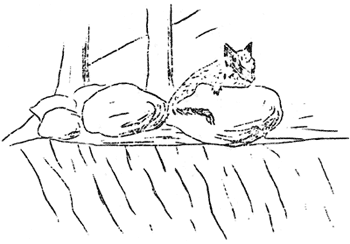|
Volume I No. 3 - September 1, 1928
Look Out Below!
By Earl U. Homuth
Something in the nature of the spectacular is often afforded
visitors to the Lake, when enjoying the boat trips. The cliff above
being almost perpendicular, a small rock becoming dislodged may create a
considerable rock-slide. The roar of this descending material can
frequently be heard for a great distance. The huge boulders dashing
into the water, and the clouds of dust which trace their path offer a
sight worth seeing.

A nature party on the rim was recently observing the antics of two
chipmunks which were skirmishing around among the rocks and along the
slope of loose gravel and sand above the topmost layer of lava. One of
these chipmunks presently dislodged a small pebble, and in rolling this
loosened others; soon a very respectable slide was cascading over the
lava cliff onto the slope below, gathering more material there and
continuing on downward toward the lake.
The slide was hardly of proportions to attract attention, but had it
been observed, any guesses as to origin would hardly have included a
chipmunk among the possibilities.
* * * * * * * * * * * * * * * * * * * *
The first family of camp-robbers are reported by Ranger Robert Beck,
from the West Entrance. They are already sociable and make the checking
station their headquarters.
Crater Lake
By Earl U. Homuth
In previous issues of these notes evidence and theories as to the
formation of the caldera in which Crater Lake lies were discussed. A
few facts concerning the lake itself may be of interest.
Since the Rim of Crater Lake is the base of the original Mt. Mazama,
drainage from the lake and into the lake is represented throughout its
entire circumference by the very edge of these cliffs alone. The walls
are exceedingly sheer. At no point is there a stream of even small size
flowing over the edge, into the caldera. The water in the lake
therefore is the rain and snow which falls upon it directly or upon the
very narrow area of the cliffs. Hence it may be considered as not only
very pure water, but actually distilled water. Any mineral content
would be negligible because of the small drainage area, and because of
the character of the rock composing the walls. Many springs, some of
considerable size, issue from the walls, and would add to the mineral
content, but this also would be proportionately insignificant
considering the quantity of water present, since the lake is nearly two
thousand feet deep, with an area of over twenty square miles.

The lake has never been known to freeze, altho others in the
vicinity and at lower altitudes are covered with ice each winter. The
normal water temperature during the summer varies between 38 ° F.
and 41°F. altho surface temperatures are of course higher.
The water level changes about four feet throughout the year, being
highest during maximum melting of snow, after the winter season and
lowest in September or early October. Precipitation is estimated to
average over 60 inches per year. Great amounts of snow are blown over
the edge of the rim. Then too, the numerous springs add to the
accretion. Evaporation is estimated to be about forty inched per year.
Calculations on the rate of lowering and rate of evaporation indicate a
more rapid lowering than could be accounted for by this agency alone.
Since there is no surface outlet the surplus probably escapes through
the porous rocks of the walls reappearing as springs which are numerous
on the southeast base of Mt. Mazama.
| 
